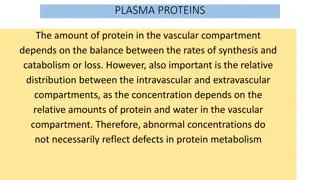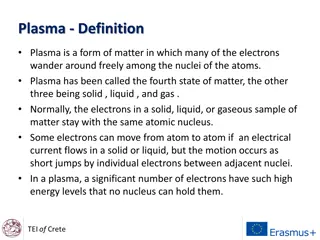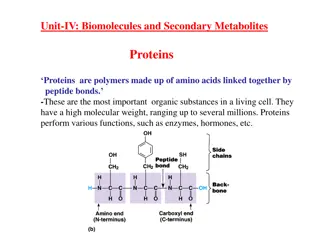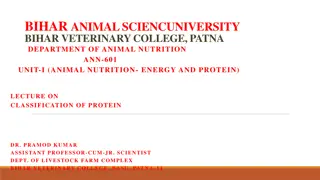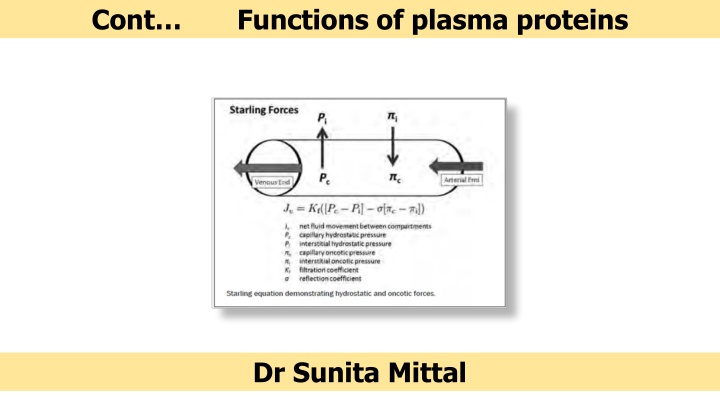
Functions of Plasma Proteins in Blood
Plasma proteins play vital roles in maintaining blood colloid osmotic pressure, viscosity, buffering action, clotting, defense functions, and transportation. Understand the significance of different plasma proteins in blood physiology.
Download Presentation

Please find below an Image/Link to download the presentation.
The content on the website is provided AS IS for your information and personal use only. It may not be sold, licensed, or shared on other websites without obtaining consent from the author. If you encounter any issues during the download, it is possible that the publisher has removed the file from their server.
You are allowed to download the files provided on this website for personal or commercial use, subject to the condition that they are used lawfully. All files are the property of their respective owners.
The content on the website is provided AS IS for your information and personal use only. It may not be sold, licensed, or shared on other websites without obtaining consent from the author.
E N D
Presentation Transcript
Cont Functions of plasma proteins Dr Sunita Mittal
Learning Objectives: At the end of this lecture student should be able to describe Types of plasma proteins Characteristics of plasma proteins Functions of plasma proteins
Functions of plasma proteins 1. Colloid osmotic pressure in blood 2. Viscosity of blood 3. Buffer action 4. Clotting and fibrinolysis 5. Defense function body 6. Transport function 7. Plasma proteolytic enzyme system 8. Plasma protease inhibitor system 9. Reserve Source
Viscosity of blood Blood is a viscous fluid and its viscosity is 4-5 times to water or 3.2 centipoise (cP). Viscosity of blood is contributed equally by blood cells & plasma proteins.
Viscosity of blood Among protein classes, the fibrous proteins fibrinogen - major contributors of the viscosity. Blood viscosity is important to maintain diastolic blood pressure as it contributes to resistance to blood flow.
NH3+ Acid Base Buffer COO- PPs provide 15% buffering capacity of blood. It is possible because of their amphoteric nature.
Coagulation and Fibrinolysis Process of Coagulation Process of Anticlotting
Body Defense function Immunoglobulins IMMUNITY Five distinct classes of immunoglobulins
Carrier or Transport Function The bound portion may act as a reservoir or depot from which the drug is slowly released as the unbound form. Unbound form is filtered, excreted and metabolized much faster. Examples-
Plasma proteolytic enzyme system There are three important proteolytic enzyme system- 1. Complement system 2. Fibrinolytic system 3. Kinin system
Plasma protease inhibitor system There is a family of proteins which inactivate/ Inhibit the various activated enzymatic proteins to regulate many processes: 1. Alpha1-protease inhibitor 2. Alpha 2-macroglobulins 3. Anti thrombin III 4. Alpha 2 antiplasmin
Reserve Source of Proteins - Act as a source of Amino acids for body tissues at the time of need. Plasma protein serves Reserve Proteins
Factors affecting synthesis of plasma proteins- Plasmapheresis (Whipple s Experiment) Plasmapheresis: a method of removing blood plasma from the body by withdrawing blood, separating it into plasma and cells, and transfusing the cells back into the bloodstream. (Clinical use-It is performed especially to remove antibodies in treating autoimmune conditions).
Self Assessment The person whose hematocrit is equal to 60% with reference to normal has . viscosity of blood. Normal total plasma protein ranges from Which component of protein contribute to maximum percentage to total plasma protein . Normal serum albumin level is . Normal A/G ratio in blood is Viscosity of blood increased with rise in and . Plasma proteins act as buffers because of Buffering capacity of plasma proteins is of total buffering capacity .


